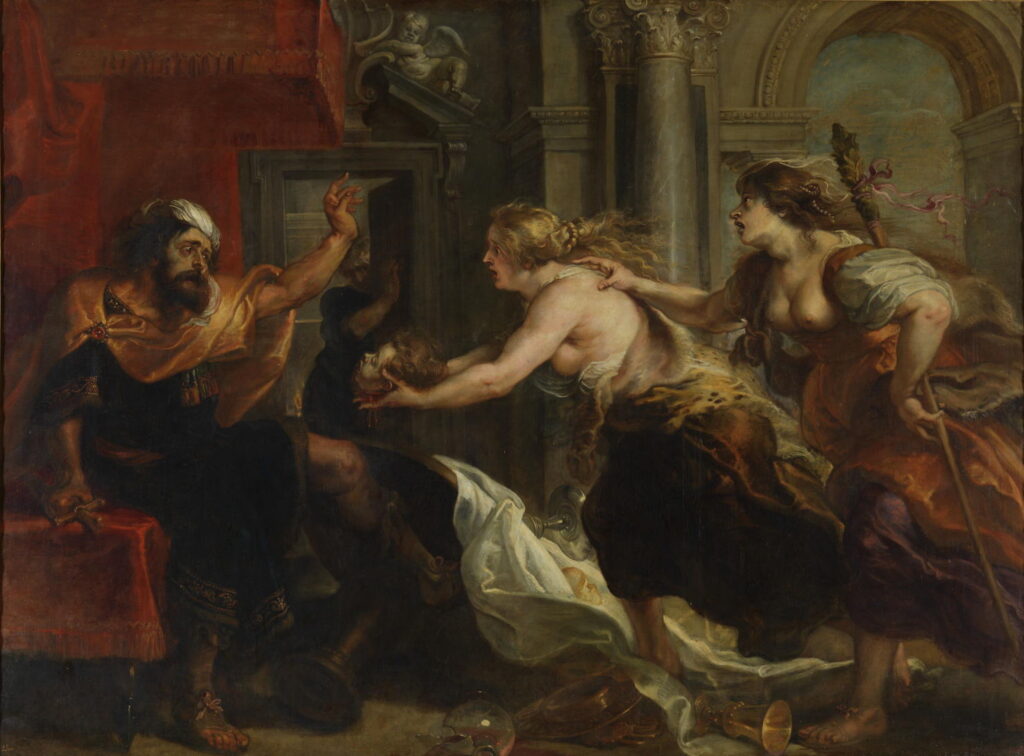Changing Paintings: 28 Philomela’s revenge

Ovid’s last substantial story in Book 6 of his Metamorphoses continues the gory trend of the slaughter of the Niobids and the flaying of Marsyas, in one of his grimmest stories of rape and its vengeance.
Ovid links from the story of Pelops with a short iteration of kings, bringing him to King Tereus of Thrace, who was descended from Mars. He married Procne, daughter of King Pandion of Athens, but from the outset their marriage seemed ill-fated. Juno, Hymen and the Graces were absent from the ceremony, but the Furies held their wedding torches instead, and a screech-owl sat on the palace roof, an ill omen indeed.
Tereus and Procne had a son, Itys, and the whole of Thrace celebrated. Five years later, Procne pleaded with her husband to let her visit her sister in Athens, or even better, for her sister to come to visit her in Thrace. Tereus agreed, and set off without her to put this request to Pandion himself. However, when Tereus met his sister-in-law Philomela, he was beguiled by her beauty and immediately lusted after her.
William-Adolphe Bouguereau (1825–1905), Philomela (1861), oil on canvas, dimensions and location not known. Wikimedia Commons.
William-Adolphe Bouguereau’s Philomela (1861) is a delightful Salon-style portrait of Tereus’ sister-in-law, who is shown clutching a lyre and wearing a laurel wreath. I cannot see any reference in this painting to Ovid’s story, nor any trace of narrative.
William-Adolphe Bouguereau (1825–1905), Philomela and Procne (1861), oil on canvas, 176 x 134 cm, Musée national du Château de Fontainebleau, Fontainebleau, France. Wikimedia Commons.
In the same year, on another tondo, Bouguereau painted a double portrait of the sisters, Philomela and Procne (1861). This time they at least appear to be involved in some sort of Bacchantic festivity, with Procne holding a tambourine. This painting was even copied and slightly elaborated by Elizabeth Jane Gardner (1837–1922), although again its relationship with Ovid’s story appears tenuous to say the least.
Tereus was therefore delighted when it was agreed that Philomela should return to Thrace to visit Procne. Pandion trusted Tereus with his unmarried daughter, and the two set off to return to Thrace by sea. Once they arrived there, Tereus dragged Philomela off to a cabin in the forest, where he raped her. Philomela was understandably horrified, shocked, and immediately told Tereus that she would shout out the truth of what he had done to her, when her father had trusted his son-in-law to take care of her.
Tereus drew his sword and grasped Philomela by the hair. She hoped that he was going to kill her, and offered him her throat. Instead of cutting her throat, he grasped her tongue with tongs, cut it out, and raped her again. Tereus then returned to Procne, who immediately asked about her sister; her husband then lied, and told her that her sister had died. Procne went into mourning for her.
A year later, still kept captive in the cabin in the forest, Philomela wove her story in red lettering on white cloth, using an old loom. She persuaded a woman to take it to the queen, who then read the truth as to what had happened to her sister.
Edward Burne-Jones (1833-1898), Philomela (1864), pencil, watercolour and bodycolour, 134.6 x 67.3 cm, location not known. Wikimedia Commons.
Edward Burne-Jones made this pencil and watercolour study of Philomela in 1864, which appears to have been abandoned. The subject is holding a weaving showing not her account in words, as stated by Ovid, but a cartoon-like sequence of images, which refer to her imprisonment, but not to her rape. Philomela’s left index finger points to her mouth, to indicate that she is mute.
Edward Burne-Jones (1833-1898), Philomela (1896), wood engraving, dimensions and location not known. Wikimedia Commons.
It wasn’t until the last few years of his life that Burne-Jones seems to have fully realised an image of Philomela (1896). This wood engraving was an illustration of The Legend of Goode Wimmen in the Kelmscott Chaucer. Philomela is shown at work on her weaving, which this time does bear some text, labelling the figures in its multiplex narrative. As in his earlier study, the story shown stops short before her rape, but shows Tereus and Philomela standing outside the entrance to a cave.
It was just coming up to the three-yearly festival of Bacchus, so Procne’s overpowering desire for revenge against her husband was channeled into that occasion. Procne found the cabin, broke into it, dressed Philomela up as a Bacchante, and took her back with her to the palace. In her rage Procne proposed to cut Tereus’ tongue out, gouge his eyes out, and castrate him.
Just then, her small son Itys came up to Procne. Mother noticed how closely her son resembled his father, and a new plan was quickly hatched. Procne pounced on her son like a tigress and stabbed him; Philomela finished the job by cutting the boy’s throat. They then cooked parts of him ready to serve.
That night, Procne dismissed the servants, and convinced Tereus that he should dine alone on his ancestral throne. Procne there served him with the flesh of his own son, which he unwittingly ate. Tereus then called for Itys, and Procne revealed that he had just eaten him. Philomela, still spattered with the boy’s blood, rushed in and threw the boy’s severed head at his father, also her rapist.
Artemisia Gentileschi (1593-1653), Procne and Philomela Showing Tereus the Head of his Son Itys (date not known), oil, dimensions not known, Galleria Nazionale della Puglia, Bitonto, Italy. Wikimedia Commons.
Artemisia Gentileschi painted her Procne and Philomela Showing Tereus the Head of his Son Itys in the first half of the seventeenth century, and shows the climax of Ovid’s story, when the sisters’ revenge is revealed to Tereus. One of the sisters, presumably Philomela, thrusts Itys’ severed head into the face of Tereus, who shields his eyes with his forearm. Sadly the quality of this image is too poor to read the details around them, but in front of the king’s left foot is a large platter on which are some of the cooked remains of his son.
Peter Paul Rubens (1577–1640), Tereus Confronted with the Head of his Son Itys (1636-38), oil on panel, 195 × 267 cm, Museo Nacional del Prado, Madrid. Wikimedia Commons.
Rubens uses a similar composition for his Tereus Confronted with the Head of his Son Itys (1636-38). The two sisters are still dressed as Bacchantes, with one carrying her thyrsus with her left arm, and their breasts are bared. Tereus is just reaching for his sword with his right hand, and his eyes are wide open in shock and rage. In the background, a door is open, and one of the court watches the horrific scene.
Tereus was beside himself with grief and anger, and chased the sisters with his sword, but they were changed into swallows, who still bear red feathers on their breast because of the murder. Tereus was turned into a hoopoe.
One contemporary insight provided by Ovid is the importance of oral testimony in a largely illiterate society. As Philomela was unable to communicate once Tereus took her power of speech away, she was driven to use the same medium as had formed Arachne’s downfall earlier in this book: that of weaving her story into tapestry, although this time using words rather than images.




